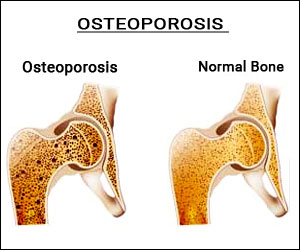- Home
- Editorial
- News
- Practice Guidelines
- Anesthesiology Guidelines
- Cancer Guidelines
- Cardiac Sciences Guidelines
- Critical Care Guidelines
- Dentistry Guidelines
- Dermatology Guidelines
- Diabetes and Endo Guidelines
- Diagnostics Guidelines
- ENT Guidelines
- Featured Practice Guidelines
- Gastroenterology Guidelines
- Geriatrics Guidelines
- Medicine Guidelines
- Nephrology Guidelines
- Neurosciences Guidelines
- Obs and Gynae Guidelines
- Ophthalmology Guidelines
- Orthopaedics Guidelines
- Paediatrics Guidelines
- Psychiatry Guidelines
- Pulmonology Guidelines
- Radiology Guidelines
- Surgery Guidelines
- Urology Guidelines
Ultrasound as good as DEXA scan for early screening for osteoporosis

Ultrasound as a modality of medical imaging was found as good as DEXA scan for early screening for osteoporosis, researchers have found in a study. Ultrasonography of the calcaneus (heel bone) was equal to data gathered using dual-energy x-ray absorptiometry (DXA), which is considered the gold standard for assessing bone health. The study has appeared in the Journal of the American Osteopathic Association.
The findings of the study may lead to lower costs and increased screening for populations at-risk for osteoporosis which study authors say extends well beyond postmenopausal women. A DEXA scan is a special type of X-ray that measures bone mineral density (BMD). DEXA stands for "dual energy X-ray absorptiometry".
Osteoporosis is a disease of bone characterized by low bone mineral density (BMD) and microarchitectural deterioration, which leads to an increase in fragility and slower healing. According to the United States Preventive Services Task Force, it is estimated that 1 of every 2 women and 1 of every 5 men are at risk for an osteoporotic fracture during their lifetime.
According to researchers, DEXA scans remain the best option for thorough, comprehensive information on a patient's bone health. But the equipment is expensive, immobile and has adverse effects of exposing patients to ionizing radiation. Because of these limitations, it becomes a difficult option to screening larger populations.
Bone mineral density (BMD) is the quality measured to determine bone health. Nutrition, lifestyle, environment, physical activity and genetics all contribute to BMD. Peak BMD is established by mid- to late-20s.
BMD decreases naturally with age, which means people who do not establish sufficiently strong bones as young adults are at increased risk for diseases like osteoporosis later in life.
"Prior research has demonstrated strong correlations between education level and socioeconomic status and bone quality," says coauthor Andrea Nazar, DO, a family physician and professor of clinical science at West Virginia School of Osteopathic Medicine. "Because of its low-cost, mobility and safety, ultrasound is a promising tool for assessing more people, across multiple demographics."
"Using ultrasound to scan the heel won't give us all the information we could gather with a full DXA scan," says Carolyn Komar, PhD, associate professor of biomedical sciences at West Virginia School of Osteopathic Medicine and co-author on this study. "However, it gives us a clear enough snapshot to know whether we should be concerned for the patient."
Dr. Nazar says the most effective lifestyle interventions for young adults are nutrition and exercise. A healthy, balanced diet contributes significantly to bone health. Also weight-bearing exercises not only build muscle, which protects bone but also strengthens the bone itself.
"Most people think our bones are static structures once we reach adulthood. On the contrary, they are dynamic and shaped by how we live," says Dr. Nazar. "There are pharmacologic options to treat osteoporosis and improve bone health, but the best approach is preventive lifestyle changes."

Disclaimer: This site is primarily intended for healthcare professionals. Any content/information on this website does not replace the advice of medical and/or health professionals and should not be construed as medical/diagnostic advice/endorsement or prescription. Use of this site is subject to our terms of use, privacy policy, advertisement policy. © 2020 Minerva Medical Treatment Pvt Ltd